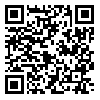Volume 10, Issue 2 (2022)
CLRJ 2022, 10(2): 122-151 |
Back to browse issues page
Download citation:
BibTeX | RIS | EndNote | Medlars | ProCite | Reference Manager | RefWorks
Send citation to:



BibTeX | RIS | EndNote | Medlars | ProCite | Reference Manager | RefWorks
Send citation to:
yahyaei M, Pouralkhas S, zahiri B. Figures of Speech, Visual Arrays: A Case Study of Abbas Kiarostami’s “Taste of Cherry”. CLRJ 2022; 10 (2) :122-151
URL: http://clrj.modares.ac.ir/article-12-36370-en.html
URL: http://clrj.modares.ac.ir/article-12-36370-en.html
1- phd of Persian Language and Literature in University of mohaghegh ardabili
2- Associate Professor of Persian Language and Literature in University of mohaghegh ardabili ,pouralkhas@uma.ac.ir
3- Associate Professor of Persian Language and Literature in University of mohaghegh ardabili
2- Associate Professor of Persian Language and Literature in University of mohaghegh ardabili ,
3- Associate Professor of Persian Language and Literature in University of mohaghegh ardabili
Abstract: (2511 Views)
From ancient times, poets and writers have used rhetorical techniques and indirect expressions to convey their concepts. The use of these techniques is one of the fundamental differences between artistic language and other common language types such as scientific language, that is the language that tries to convey the concept to the audience with the most explicit terms and far from ambiguity. In cinema as a modern art, which has a deep and inseparable relationship with literature, figures of speech always help cinematographers to convey the concepts. The cinematographers, knowingly or unknowingly, supported by the linguistic and literary culture in which they have been raised, use these devices to illustrate their purposes.
The role of literature in cinema can be examined at three levels of language, image, and content. This study, focuses on the images and the case of “Taste of cherry” directed by by Abbas Kiarostami as one of the most prominent Iranian artists in cinema in order to use the images, their role in conveying the concepts and figures of speech used in the film. Investigating figures of speech in the image of a cinematic work makes the audience closer to the intellectual world of the filmmaker, reveals how his works interact with written literature, gives a deeper understanding regarding the link between the two arts, and shows the influence of the past written legacy in the cinema, as the most recent human art.
The role of literature in cinema can be examined at three levels of language, image, and content. This study, focuses on the images and the case of “Taste of cherry” directed by by Abbas Kiarostami as one of the most prominent Iranian artists in cinema in order to use the images, their role in conveying the concepts and figures of speech used in the film. Investigating figures of speech in the image of a cinematic work makes the audience closer to the intellectual world of the filmmaker, reveals how his works interact with written literature, gives a deeper understanding regarding the link between the two arts, and shows the influence of the past written legacy in the cinema, as the most recent human art.
Article Type: Original Research |
Subject:
Relationship of Adaptive Literature with Fine Arts
Received: 2019/09/11 | Accepted: 2020/02/5 | Published: 2023/03/1
Received: 2019/09/11 | Accepted: 2020/02/5 | Published: 2023/03/1
Send email to the article author
| Rights and permissions | |
 |
This work is licensed under a Creative Commons Attribution-NonCommercial 4.0 International License. |







